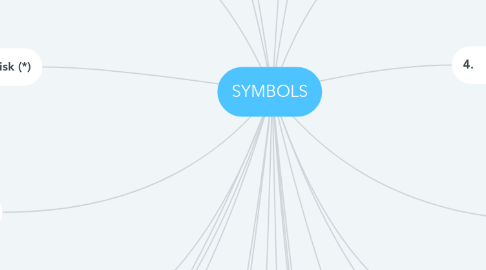SYMBOLS
作者:Nestor Ayala

1. 7. Dollar sing ($)
1.1. Is used to represent the dollar and peso. Eg. I bought my daughter a new bike for Christmas for $75.
2. 8. Percentage sing (%)
2.1. Is mostly used in informal writing, advertisements or tables in research papers. Newspapers and magazines might also use the percent sign to save space. Eg. 25% of the children were male
3. 9. Ampersand (&)
3.1. Should only be used in very informal writing unless it is being used in a formal company name. Eg. At the zoo we saw lions, zebras, bears & monkeys.
4. 10. Asterisk (*)
4.1. We use the asterisk in English writing to show that a footnote, reference or comment has been added to the original text. Eg: *first footnote; **second footnote;
4.2. ***third footnote
5. 11. Hash (#)
5.1. (#): We mostly use the number sign in informal writing, such as emails, texts, journal entries and advertisements. Eg. Tim was #15 in line.
6. 12. Brackets ([ ])
6.1. Is used for technical explanations or to clarify meaning. If you remove the information in the brackets, the sentence will still make sense. E.g: He [Mr. Jones] was the last person seen at the house.
7. 13. Left bracket (()
7.1. In writing, parentheses can be used to express additional information, an aside, or special remarks. For instance, "The child received a stern lecture (and he deserved it)."
8. 14. Square bracket ([ ])
8.1. ]): Are occasionally used in especially complex expressions in place of (or in addition to) parentheses, especially as a group symbol outside an inner set of parentheses, e.g., .
9. 17. Plus sign (+)
9.1. Is most often used in programming and mathematics to add two or more numbers or as a programming operator.
10. 19. Colon (:)
10.1. Has three main uses. The first is after a word introducing a quotation, an explanation, an example, or a series. E.g. He was planning to study four subjects: politics, philosophy, sociology and economics. The second is between independent clauses, when the second explains the first, similar to a semicolon: E.g: I didn’t have time to get changed: I was already late. The third use of a colon is for emphasis: E.g There was one thing she loved more that any other: her dog.
11. 21. “At” sign (@)
11.1. is most commonly used in email addresses and on Facebook and Twitter.
12. 23. Backward slash (\)
12.1. Is mainly used in computer file names, especially in Windows. Eg. C:\Program Files\Windows
13. 1. Full stop (.)
13.1. Is the most common form of punctuation used to end a sentence in the English language. Periods are also used for abbreviations and website addresses. Eg: The shirt is blue.
14. 2. Comma (,)
14.1. Is used to show a separation of ideas or elements within the structure of a sentence. Additionally, it is used in numbers, dates and letter writting after the salutation and closing. Eg. Thanks for your help, Jhon
15. 3. Exclamation mark (!)
15.1. Is used when a person wants to express a sudden outcry or add emphasis. E.g. My brother in law makes me feel happy!
16. 4. Question mark (?)
16.1. To indicate a direct question when placed at the end of a sentence. Eg. When did Julie leave for the market?
17. 5. Single quotes (´)
17.1. Is use when a quotation or a title is placed inside of another quotation. Eg. My mother said, 'The baby started talking today. The baby said, "Mama".'
18. 6. Double quotes (“ ”)
18.1. is used in written language to quote exact words from spoken or written language. Eg. She said, "Come home."
19. 15. Underscore (_)
19.1. Is mainly used to show a space where a space is not allowed, such as in internet usernames, email addresses and some computer programs. Eg. bill_hamilton@sample.com
20. 16. Hyphen (-)
20.1. Is used to join two or more words together into a compound term and is not separated by spaces. E.g: Part-time, back-to-back, well-known
21. 18. Equals sign (=)
21.1. Is a value or data that is the same or equivalent to another value
22. 20. Semicolon (;)
22.1. Is used to connect independent clauses. It shows a closer relationship between the clauses than a period would show. Eg. Mario was hurt; he knew she only said it to upset him
23. 22. Forward slash (/)
23.1. Is used to separated parts of Internet (Web) addresses and file names for some computers programs. Eg. http://www.really-learn-english.com/esl-ebooks
24. 24. Arrow (←→)
24.1. is a graphical symbol such as ← or →, used to point or indicate direction, being in its simplest form a line segmentwith a triangle affixed to one end, and in more complex forms a representation of an actual arrow (e.g. ➵ U+27B5). The direction indicated by an arrow is the one along the length of the line towards the end capped by a triangle


